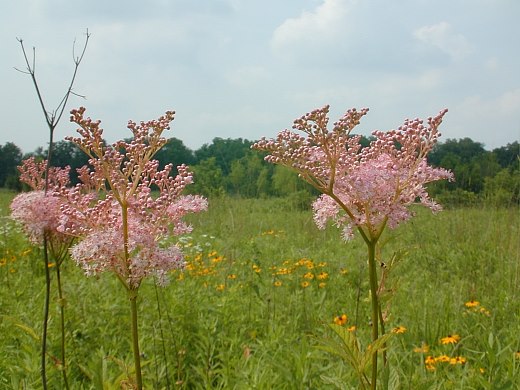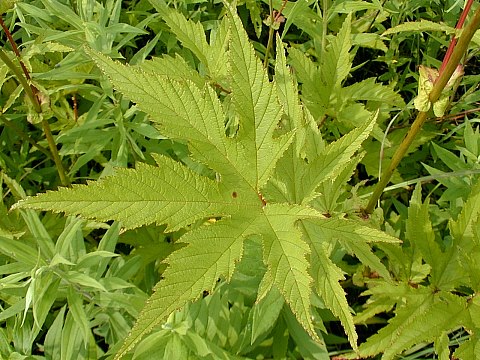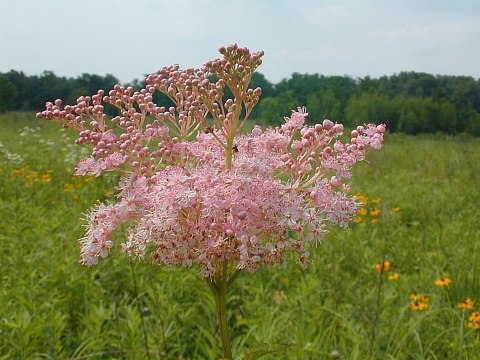Description: This herbaceous perennial plant is unbranched and about 3-6' tall. The central stem is smooth and sometimes reddish. The alternate compound leaves are up to 2' long. They are often yellowish green, and become much smaller and sparser while ascending the central stem. Each compound leaf consists of 1-7 palmate leaflets that are aligned along each reddish leaf-stem in succession. Each leaflet is up to 6" long and across and has 2-5 cleft lobes. The margins are coarsely dentate.

The inflorescence
occurs on a long naked stalk, consisting of a panicle of pink buds and
flowers about 5-8" across. Each flower is about 1/3" across, consisting
of 5 pink petals and numerous long white stamens with pink anthers. The
overall appearance of the inflorescence resembles wind-tossed fluff or
foam, and is quite beautiful. The flowers bloom from the bottom up, and
have little or no fragrance. The blooming period occurs from early to
mid-summer, and lasts about 3 weeks. Afterwards, straight reddish
fruits develop that are about ¼–½" across. The root system consists of
a taproot and rhizomes. Queen-of-the-Prairie tends to form colonies
under moist conditions.
Cultivation:
The preference is full or partial sun, and wet to moist conditions. The
soil should be high in organic content, and can contain a little sand.
The cooler climate of the Great Lakes region is preferred, rather than
hot, dry summer heat. Occasionally, the leaves become spotted from
foliar disease, otherwise it is not subject to any special problems.

Range &
Habitat:
The native Queen-of-the-Prairie occurs primarily in scattered counties
along the
upper basin of the Illinois River and in the Chicago area. It has also
been observed in east central Illinois (see Distribution
Map), where it has been successfully introduced. This
uncommon plant is listed as 'threatened' in Illinois. Habitats include
moist black soil prairies, moist sand prairies, moist meadows along
rivers in woodland areas, shrubby fens, and wet areas in or around
seeps and springs. This is an indicator plant of high quality habitats,
although in some areas it has been introduced as part of restoration
efforts.
Faunal Associations:
The colorful flowers provide pollen as a reward for insect visitors,
but not nectar. Various species of bees collect pollen from the flowers
and probably are the most important pollinators. Beetles and flies feed
on the pollen. Wasps and butterflies may land on the flowers looking
for nectar, but their search will be futile. Little is known about the
floral-fauna relationships for birds and mammals. The foliage doesn't
seem to be bothered by deer and other herbivorous mammals.

Photographic
Location: The photographs were
taken at Meadowbrook Park in Urbana, Illinois.
Comments:
This is a wonderful plant, if only it would bloom longer! In prairies,
the pink flowers rise above the surrounding vegetation and can be seen
from a considerable distance. It has a very distinctive appearance, and
can't be confused with any other native plant. However, the introduced Filipendula
ulmaria (Queen-of-the-Meadow) is somewhat similar. This
latter species differs from Queen-of-the-Prairie by having white
flowers and twisted fruits.